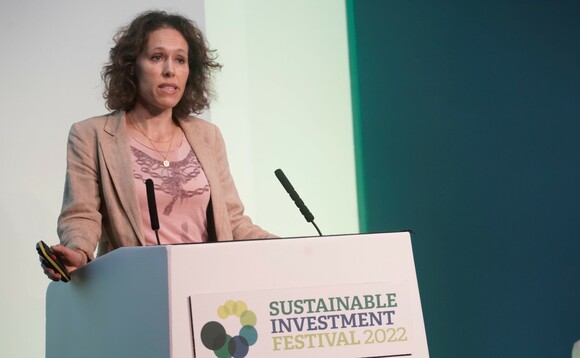Article 8 labelled funds have experienced net outflows so far in 2022 while Article 9 funds have maintained popularity with investors in spite of market headwinds.
During her presentation at the Sustainable Investment Festival Hortense Bioy (pictured), global director of sustainability research at Morningstar, revealed that Article 8 funds have been more affected by the "challenging" market environment the past few months, experiencing net negative inflows year-to-date.
At the same time general Article 6 funds were net-positive for fund flows in Q1, but this trend turned negative in April-May.
Article 9 funds on the other hand have held up better since the start of the year, maintaining net-positive inflows.
As Bioy said: "It has been a good story for Article 9 funds, not so much for Article 8".
SIF 2022 Blog: All the news and views from day one
The different fund labels refer to the various categories under the current EU SDFR regulation.
Article 6 refers to ‘general' portfolios, essentially any fund available and is not promoting an explicit ESG focus other than risk assessment.
The other two, 8 and 9, have a keener ESG focus with the former applying to funds promoting social and environmental goals, taking then more into consideration than just a risk assessment.
Article 9 funds go one step further, requiring a core ESG objective and focus.
2022 has been a tough year for fund flows generally, especially in the equity space where frequent volatility, increasing inflation and rising interest rates are creating headwinds. This is combined with a depressive social and political backdrop.
ESG and sustainable-focused funds had been on a positive ride prior to 2022, in tangent with investors' awareness and consideration of climate and social issues growing.
Data from Morningstar showed that this was an especially strong trend in Europe, with 82% of global ESG funds made up by European assets.
Europe has very been a leader in this area of the market, launching its SFDR regulation in March last year and further data from Morningstar confirming this. In total, Article 8 and 9 funds account for €4.3trn, "almost half of EU fund assets", Bioy said.
Bioy added that inflows were a key driver to asset development in this space, alongside "product innovation".
SIF 2022: Opperman calls for 'green deal of sustainable investment'
At the moment, ESG-focused funds tend to fall in the equities space, typically as an active fund.
"I think we are going to see more product development in that space," said Bioy. She highlighted that 84% of ESG funds are equity funds and therefore "fixed income is underrepresented right now".
One other peculiarity Bioy highlighted between Article 8 and 9 funds was that among the 20 largest Article 8 portfolios, only two included the term ESG or sustainable in its name, and that they were the passive options: Northern Trust World Custom ESG Equity Index fund and iShares MSCI USA SRI ETF
This was almost the total opposite from the Article 9 list, where most fund names included explicit ESG language.
Because of the lower ESG requirements of Article 8 Bioy said that this can lead to some "confusion and accusations of greenwashing because these funds would not have been marketed as ESG prior to SFDR but now they are saying that they are ‘light green'.
"So that has caused some confusion," Bioy said, but confirmed that these Article 8 funds are ‘ESG integrated'.





